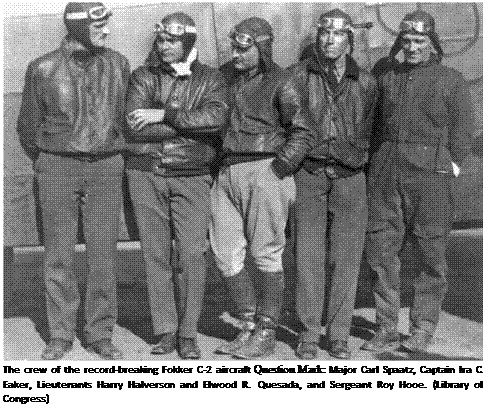1929
 |
JANUARY 1 —7 Over Los Angeles, California, the Fokker C-2 Trimotor Question Mark, piloted by Army Major Carl Spaatz, Captain Ira C. Eaker, and Lieutenants Elwood Quesada and Harry Halveson, establishes a flight endurance record of 150 hours and 40 minutes. They are refueled 37 times by a pair of specially rigged Douglas C-1 transports.
JANUARY 9—16 A Fokker C-2 transport piloted by Major Paul Beck flies 3,130 miles from Wright Field, Ohio, to France Field, Panama Canal Zone, becoming the first military aircraft ferried abroad by the Army Air Corps.
February 23 At Wright Field, Ohio, the perfection of heated goggles, gloves,
and oxygen bottles is announced by the laboratory there.
April 14 In a major development, Edward A. Link patents his “flight trainer” (or flight control simulator), which becomes part of every pilot’s basic flight instruction. By the advent ofWorld War II, over half a million American and Allied pilots train on these devices en route to getting their wings.
May 16 In Hollywood, California, the World War I aerial drama Wings receives the first Oscar award for best picture. The film was shot with many real and reconstructed World War I fighter craft and highlights the nation’s continuing interest in aviation.
May 21—22 In response to a directive from Assistant Secretary of War for Aviation Turbee Division, the Army Air Corps directs a Keystone bomber to fly roundtrip and nonstop from Dayton, Ohio, to New York. However, the mission is scrubbed when bad weather grounds the refueling aircraft. The bomber continues on to Washington, D. C., and, on the following day, rendezvous with the tanker.
May 30 In Washington, D. C., a Liberty – powered DH-4 completes cross-country air refueling tests while flying in from New York.
July 17 Near Auburn, Massachusetts, Dr. Robert H. Goddard successfully test launches a liquid-propelled rocket that carries a camera aloft which takes photos of a barometer and a thermometer on board.
AUGUST 15 In Spokane, Washington,
Lieutenants Nicholas B. Mamer and Arthur Walker fly their Buhl Sesquiplane Spokane Sun God nonstop to the East
Coast and back. They cover 7,200 miles while being refueled in the air 11 times.
September 24 At Mitchel Field, New York, Lieutenant James H. Doolittle makes aviation history by successfully completing the first “blind” airplane flight. He flies his Consolidated NY-2 biplane for hours in a canvas-covered canopy using only instruments and no radio. Years later, Doolittle considered this feat his greatest contribution to aviation.
NOVEMBER 23 In New York, the Daniel Guggenheim Fund for the Promotion of Aeronautics awards Dr. Robert H. Goddard a $50,000 grant to assist his research with rockets.
November 29 Over Antarctica, a Ford Trimotor flown by Navy Commander Richard E. Byrd, Bernt Balchen, and Harold June makes an epic flight across the South Pole for the first time. They are accompanied by Army captain Ashley McKinley, who serves as the trip photographer.










